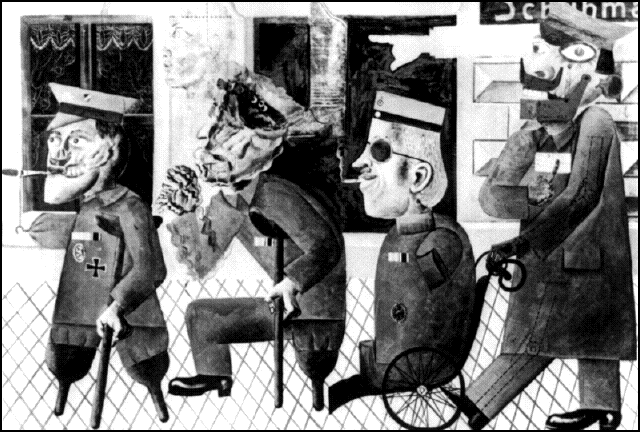Victorian
Murder
The Fatal Bullet
Rick Geary
(Nantier Beall
Minoustchine)
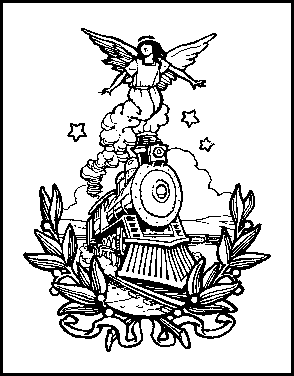 The best retelling of the murder of James A. Garfield was recorded fifty years ago by Bascomb Lamar Lunsford, the collector of Appalachian folk music. The record is long gone, but I can still remember him reciting, in his gravelly North Carolina mountain voice, "They say you are feeling mighty poorly, Mr. Garfield."
The best retelling of the murder of James A. Garfield was recorded fifty years ago by Bascomb Lamar Lunsford, the collector of Appalachian folk music. The record is long gone, but I can still remember him reciting, in his gravelly North Carolina mountain voice, "They say you are feeling mighty poorly, Mr. Garfield."The second best retelling --- better than any of those history books they tortured us back at Garfield High --- is this seventy-two page comic book by Rick Geary.
The facts are all there: that Charles J. Guiteau was well known in the White House; that he had harassed Garfield and Secretary of State Blaine endlessly during the summer of 1881 to be Consul to Paris; that he was presented with endless chances to murder the President (no Secret Service in those days); that once shot, Garfield lingered on in great pain from July 2 to September 19th (and was probably done in by incompetent medical help); and that Guiteau was the first of the Unabomber-style publicity-hound assassins --- in other words, using the death of others to get one's doubtful message across (the newspapers and magazines printed many of his writings).
It's an odd, a very odd way to get one's political thoughts heard, and Guiteau made it even more appalling by intoning such lines as "Life is a fleeting dream, and it matters little when one goes," and, "I presume the President is a Christian and that he will be happier in paradise than here," and, "I have no ill-will toward the President. His death is a political necessity."
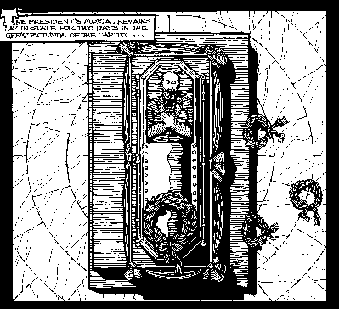 Of course, Guiteau affected the operations of the United States far more than Garfield did. One man with one gun and two bullets created, single-handedly, the dratted Civil Service System which presents us with all those 8 am - 4 pm G-11 Civil Servants who will do anything to keep from answering our questions. He also started us on the path of separating our elected officials from the common folk. Which, if you doubt, just you try to get an appointment with your Senator or Representative --- much less your President --- to tell him what you think of his government.
Of course, Guiteau affected the operations of the United States far more than Garfield did. One man with one gun and two bullets created, single-handedly, the dratted Civil Service System which presents us with all those 8 am - 4 pm G-11 Civil Servants who will do anything to keep from answering our questions. He also started us on the path of separating our elected officials from the common folk. Which, if you doubt, just you try to get an appointment with your Senator or Representative --- much less your President --- to tell him what you think of his government.
No matter. Geary brings the whole era --- and the two main characters --- to life, and its great comic book reading, and why didn't they have history books like this when you and I were going to school?
Talk
Narratives of
Psychotherapy
Lillian R. Furst
(The University Press of Kentucky)
Dr. Furst's writing is a bit thick, and her purpose is serious --- but for this reader, her Preface, "From Eyes to Ears," is worth the whole price of the book. She has managed to contract into some twenty pages or so the best precis we've found of the early history of "talk therapy." She gives due attention to the work of Jean-Martin Charcot, who was of no little inspiration to Freud --- but she points out that besides Charcot's work with hypnosis, he was in the habit of showing off his patients, often dramatizing their tics and mannerisms --- and certainly not allowing them to frame an interchange interaction between doctor and patient. She says that his technique was one of "eye" over "ear," --- eg, consistently looking and observing, never listening.
Dr. Furst claims that the most important writing of Freud might well be the early Studies in Hysteria with discussion of five patients, including the famous Anna O. For these "hysterics" with their typical symptoms of paralysis and panic, Freud would begin with massage (administered by himself), then a session of hypnotherapy, and then, a primitive form of "talk therapy." In each of the five cases, she says, we can begin to observe the change in Freud's techniques --- to the point where with "Emmy" he drops the massage, and the hypnotherapy, and utilizes exclusively talk.
Freud is quick to realize that her talk ist nicht so absichtslos, wie es den Anschein hat ("is not as unintentional as it appeared.") It was, he remarks, as if she had adopted his strategy, and was using the apparently casual...conversation, induced by chance, to supplement the hypnosis.
It is a quick jump from that to what was to be the most original and telling change in Freud's operating system; the one that was to change our view of humans, of the mind, of the roots of anguish; and how that anguish could be mitigated, and --- in some cases --- expunged:
He comes to grasp too that his cardinal error...lies not in his occasional misunderstanding of what she says but in his interrupting questions, in short in not letting her do the telling at her own pace and will. His patient is teaching him a crucial lesson when she makes an open protest Nun sagte sie recht mürrisch, ich solle nicht immer fragen, woher das und jenes komme, sondern sie erzählen lassen, was sie mir zu sagen habe. ("She said quite crossly, I was not to keep on asking her where this or that came from, but to let her tell me what she had to say.") So it is a rebuke from a patient that sets him on the royal road to the spontaneous talk absent in hypnosis and quintessential to psychoanalysis.
This one got us. The thought that one of the astounding discoveries of our time (the power of a benign, non-intervening, non-judgmental doctor letting a patient set the pace of revelations) came about because Freud asked one too many questions, so that Emmy finally had to tell him to shut the hell up so she could say what she had to say without interruption. This thought quite delighted us, especially those of us who are always on the lookout for what some call "the breakpoint."
"When the attentive, forbearing ear displaces the scrutinizing, judgmental eye, a revolution of a dimension perhaps greater than any ever before took place in the history of psychotherapy," says Dr. Furst:
Encouraging patients to talk openly and listening to what they say --- with an ear alert also to what they do not say --- denoted a complete break with the long established tradition of silencing them and hoping to mitigate their distress by physical remedies or some sort of distraction. Whatever the controversies about the validity of Freud's actual theories, the method he devised is in many respects still at the core of individual psychotherapy as it is practiced today. For it is Freud who changed the role of patients through their talk, by having them tell their tale in their own way.
Dr. Furst, too, has many interesting tales to tell and stories and books to interpret --- but her discussion of the origins of modern psychotherapy alone is excellent, and well worth your attention.
Post-
Expressionism
The Art of
The Great Disorder
1918 - 1924
Dennis Crockett
(Penn State Press)
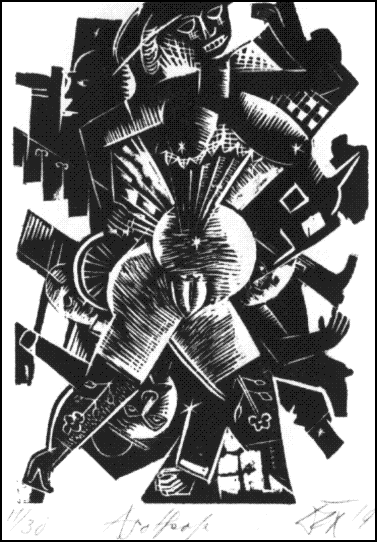 They called it Die neue Sachlichkeit which might be translated as "the new matter-of-factness," or "the new resignation," possibly even, "the new blah." The paintings were ghastly --- probably the first time, outside of the works of Bosch and Soutine, that canvas was specifically used to evoke such disgust and horror.
They called it Die neue Sachlichkeit which might be translated as "the new matter-of-factness," or "the new resignation," possibly even, "the new blah." The paintings were ghastly --- probably the first time, outside of the works of Bosch and Soutine, that canvas was specifically used to evoke such disgust and horror.Crockett spends much of the introduction explaining to us influences, and Dada, and Post-Expressionism, but, certainly, the roots were more simple than that. It came from the First World War, which --- for all Germans --- was unmitigated horror; much more, at least, than for any other country except Russia. Almost a third of German males were killed or disfigured at the eastern or western fronts. Four years of total war created nothing but hardship and hunger. At surrender in November of 1918, after a gruelling, ugly 52 months --- the Germans had little to show for their efforts but poverty, hunger, destitution, a destroyed infrastructure, and rapacious victors.
The post-war period covered in this book was one of even more horrors: a slow national recovery being sabotaged by the Allies with demands for onerous reparations, the subsequent 30-month occupation of the Ruhr which caused an hyperinflation that quite wiped out the hopes and finances of the entire German middle class. The conclusion of all this, of course, was a stability which finally came, in 1933. A very ominous kind of stability --- that was to further destroy the country.
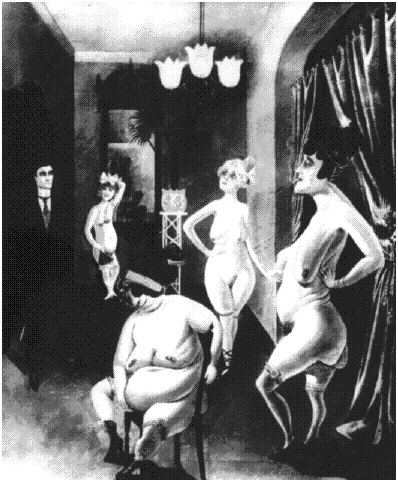
Out of this very unhappy time came some very unhappy art --- and it is, even now, seventy years after the fact, highly disturbing art. The editor has reproduced herewith some 115 paintings and drawings, including some of the most famous of George Grosz, Georg Schotz, Otto Dix, Otto Griebel, and Heinrich Maria Davringhausen. The works reproduced here are vicious --- in a beautiful way (or perhaps quite beautiful in a horrible way), but the price, obviously, was ruinous to all concerned. (Ghastly beautiful art represented a world that was hardly beautiful).
For this particular edition, the pity is that many of the originals were in color, and are here reproduced in black and white. Still, the effect is overwhelming. There's Grosz' representation of the murder of his friend Gustav Landauer. There's Scholz' diabolical painting of the rich profiteering farmer family. There's what appears to be an exploding woman by Otto Dix [see Fig. 1 above].
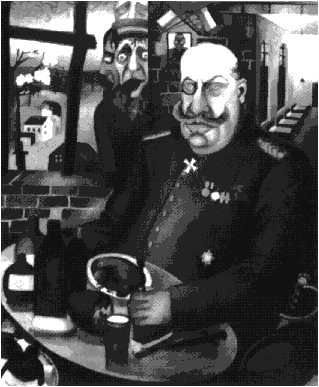 There's Griebel's hideously deformed soldiers (something that could be seen on any of the streets of any of the major German cities after the war.) There's Stöcklin's strange primitive vistas of city life --- perversions of the idyllic visions of Henri Rousseau. There are portraits of generals, businessmen, farmers, and of the bourgeoisie --- individuals and families who appear to the artist (and to us) as pure craven evil. Women are displayed as objects (or creators) of ill-disguised violence. Soldiers and ex-soldiers are represented as basket-cases --- not maudlin, but bleak and cartoon-like in their disfigurement. Even a simple painting of an electric tram is charged with nightmare overtones. The violence of a life of war, disfigurement, and greed is presented to us in unforgiving, horror-comic fashion.
There's Griebel's hideously deformed soldiers (something that could be seen on any of the streets of any of the major German cities after the war.) There's Stöcklin's strange primitive vistas of city life --- perversions of the idyllic visions of Henri Rousseau. There are portraits of generals, businessmen, farmers, and of the bourgeoisie --- individuals and families who appear to the artist (and to us) as pure craven evil. Women are displayed as objects (or creators) of ill-disguised violence. Soldiers and ex-soldiers are represented as basket-cases --- not maudlin, but bleak and cartoon-like in their disfigurement. Even a simple painting of an electric tram is charged with nightmare overtones. The violence of a life of war, disfigurement, and greed is presented to us in unforgiving, horror-comic fashion.
All this art grew out of the much-maligned Weimar Republic and, with the coming of Hitler, the artists were forced underground. The Nazis prepared shows of "decadent" art, and put Ott and Grosz and the other Post-Expressionists at the very top of the list. Everything that Goebbels wanted to show as heroic, contributing to the stability of the military state was exactly that which inspired the Post-Expressionists to the height of their satiric (and wonderful) art.
